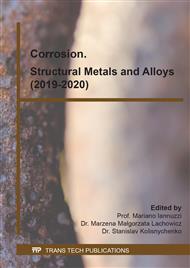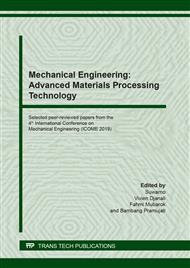p.1
p.8
p.17
p.25
p.32
p.41
p.48
p.54
Corrosion Behavior of a Predeformed Fe-Ni Lateritic Steel with Bainite Structure
Abstract:
In a railway track for intermodal usage between a train station to a port, an observation on corrosion behavior of the track alloy in the coastal environment needs to be considered. In this study, Fe-Ni lateritic steel with bainite structure is observed. This alloy is developed from lateritic ores in Indonesia as an alternative to the conventionally made Fe-Ni steels. This study aims to determine the effect of cold rolling and austempering processes on the corrosion properties of the alloy. The cold-rolling reductions used are 30% and 70%, followed by an austempering process at 400°C for 30 mins with air cooling. The corrosion test was performed on four different samples-- First, a before deformation sample. Second, 30% and 70% cold-rolled samples. Third, austempered without deformation samples. Besides, fourth, deformed austempered samples. The corrosion test method implemented was the CASS Method for 2, 4, and 6 days. The highest corrosion rate obtained by 30% cold rolling, and the corrosion rate is increased as the austempering addition. The microstructures of rust are approximately porous few compact, near to voluminous coarse-grain corrosion products, and tend to crack.
Info:
Periodical:
Pages:
8-16
Citation:
Online since:
October 2020
Keywords:
Price:
Сopyright:
© 2020 Trans Tech Publications Ltd. All Rights Reserved
Share:
Citation:



